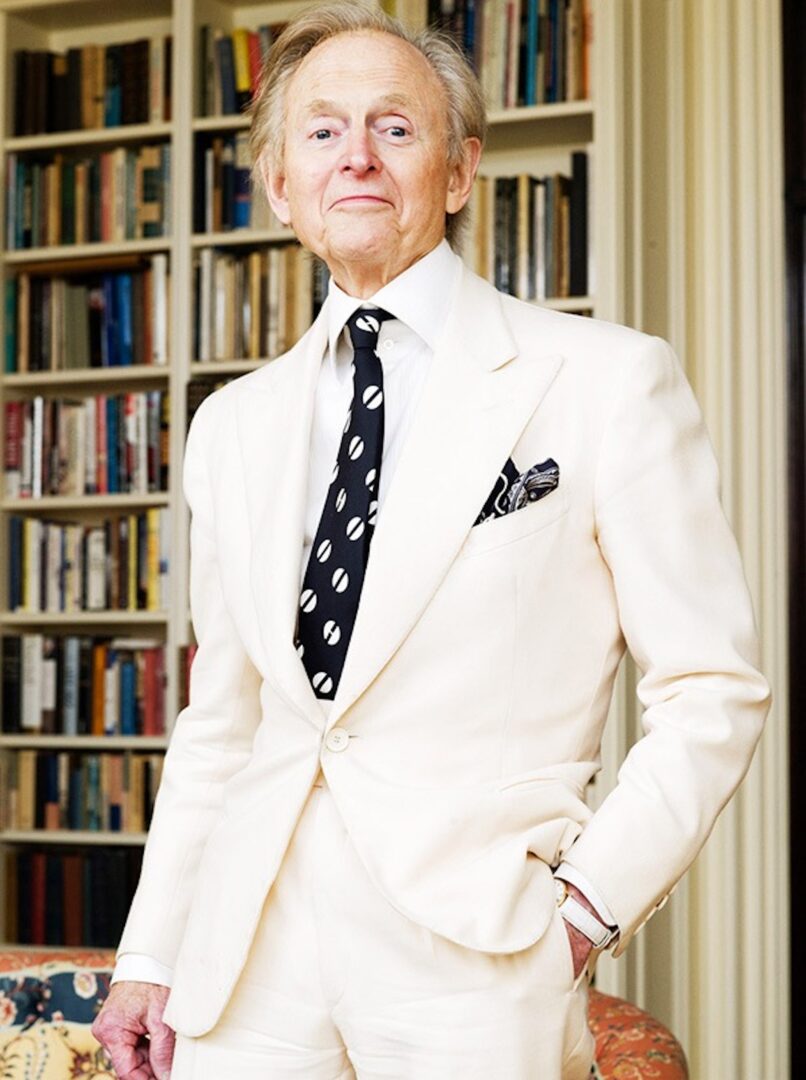The publication in 1998 of A Man in Full, Tom Wolfe’s mammoth novel about the making of modern Atlanta, became the biggest single event in the city’s cultural life since the world premiere in 1939 of Gone With the Wind at Loew’s Grand Theater. Wolfe’s impact on Atlanta has been compared with General William T. Sherman’s Atlanta campaign in 1864, and his judgments were given the same weight as International Olympic Committee President Juan Antonio Samaranch’s critical assessment of Atlanta’s Olympic Games of 1996.
Wolfe’s Literary Career
Wolfe, born and raised in Richmond, Virginia, is a former newspaper reporter and the best-selling author of such works as The Kandy-Kolored Tangerine-Flake Streamline Baby (1965), The Right Stuff (1979), and The Bonfire of the Vanities (1987).
Two weeks before the novel’s publication, the November 2 cover of Time magazine featured Wolfe’s portrait and the announcement “Tom Wolfe Writes Again.” Cover stories and lavish photo layouts also appeared in American Spectator, Vanity Fair, Harper’s, Biblio: Exploring the World of Books, Book: The Magazine for the Reading Life, and even Delta Air Lines’s in-flight periodical Sky. Eleven years in the works, Wolfe’s much-anticipated second novel was eminently newsworthy—his first fictional effort since The Bonfire of the Vanities, the satire set in New York City, which had sold 750,000 copies in hard cover. A Man in Full immediately topped best-seller lists, was nominated for a National Book Award, and became target for controversy—especially in Atlanta. The fact that Wolfe, a New Yorker since the early 1960s, was an outsider only exasperated the issue.

Image from medusahead
In anticipation of Wolfe’s arrival in Atlanta in mid-November 1998, timed to coincide with the official release of his novel, the Atlanta Journal-Constitution began issuing a “Wolfe Watch.” The Buckhead Coalition withdrew its invitation for him to speak at its annual meeting because of Wolfe’s purported “Buckhead bashing” in the book. The Atlanta Convention and Visitors Bureau, on the other hand, invited the author to its own big-bash breakfast in the hope that the book might do for the tourist trade in Atlanta what Midnight in the Garden of Good and Evil had achieved for Savannah. An overflow audience attended a reading from the novel on November 18 at the Atlanta History Center, after which 150 well-heeled admirers paid $600 each for a dinner in Wolfe’s honor that would benefit the Margaret Mitchell House and Museum. The next morning, some 1,100 people crowded a Buckhead bookstore to purchase autographed copies of A Man in Full. For its Christmas decorations a few weeks later a downtown clothier presented in the windows of its Peachtree Street store a display entitled “A Christmas in Full”: mannequins dressed as characters from Wolfe’s novel.
The Novel
A Man in Full captivated Atlantans because it headlined the city’s quintessential mythic hero: the entrepreneur, the booster, the developer, the leader. Such an individual, real or imagined, historical or contemporary, serves as the embodiment of the progress-at-any-price “Atlanta spirit.” Since the city possesses no natural advantages—such as access to a harbor or navigable river, proximity to mineral deposits, or dominance over an agricultural hinterland—Atlanta’s sole reason for being has always been its potential for development. The Atlanta spirit is governed not by the city’s past but by its purportedly boundless future. Margaret Mitchell’s Scarlett O’Hara embodies that expansionist ethos for the nineteenth-century city; Tom Wolfe’s hero, Charlie Croker, does the same for the twentieth-century megalopolis.
Early in the novel the sixty-year-old developer seems to have accumulated all the markers of turn-of-the-century achievement: a 29,000-acre “show plantation” in his native south Georgia, an English manor house in suburban Buckhead, a wife half his age to grace them, flights of corporate jets and fleets of company limos, and his own “edge city”—a massive multiuse mall on the northern frontier of an exploding Greater Atlanta. Croker Concourse, the crown jewel in his economic empire, stands more as a monument to “Cap’m” Charlie’s ego than to his business acumen. Ignoring the three cardinal rules of real-estate development—location, location, location—Croker gambles that the next wave of suburban expansion will wash up against his distant development; instead, the wave crests and then recedes. Croker Concourse is left high and dry—and empty. The builder’s bubble on which it was erected quivers, then bursts.
The central plot of A Man in Full involves its hero’s abortive attempts to save both his financial empire and his sense of self-worth. Croker’s efforts are quickly compromised by the politics of race in the self-proclaimed “City Too Busy to Hate.” A sexual incident between a Georgia Tech football star and the daughter of a major power broker—consensual sex according to the Black athlete, date rape according to the white debutante—threatens to widen the already considerable fissure that marks the city’s racial fault line. The threat of bad publicity, a challenge to Atlanta’s claims for being the nation’s (according to some of its boosters, the world’s) civil rights capital, calls for problem solving “the Atlanta way.” As lines are drawn between the races, as well as between classes on each side of the city’s color line, negotiations between Atlanta’s two major power groups—Black politicians and white businessmen—are set in place for behind-the-scenes, back-door, Atlanta-style politics. The designated spokesman for the Atlanta way this time around, both factions agree, will be Charlie Croker, legendary Tech football star and edge-city entrepreneur. How well he performs in this role would seem to determine his fate, both financial and personal.
The subplots of A Man in Full detail the machinations of investment bankers in recouping corporate losses while guaranteeing their own personal gain; where and how the city’s elite—on both sides of its racial divide—live, play, and create their own distinctive communities and subcultures; the creation of new immigrant enclaves (from California to Georgia) under the pressures of economic globalization; as well as the language and inner dynamics of a multiracial, coast-to-coast jailhouse culture.
For page after page Wolfe’s Atlanta novel provides detail after detail of numerous slices of the city’s life. Its satiric narrative, responsible for much of the local controversy surrounding the novel, faults Atlanta for its obsession with boosterism, expansion, and hollow social platitudes about racial harmony. In socioscientific terms, its reach is both anthropological and sociological. As much as any sprawling social novel can, A Man in Full captures wide swatches and many levels of today’s Atlanta in full.






